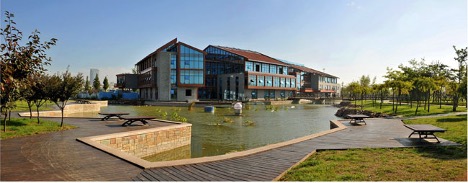Posted February 17, 2021
By SUMMER XIA
QINGDAO, China — Zhisheng Liu stops in front of the most famous artwork at Mingjia Art Museum here and carefully examines it.
It is 2 p.m., which usually the museum’s busiest time, but there are less than 10 people in the modern facility. So, it is the first time that Liu has the chance to dive into that painting profoundly and personally.
However, across the hallway, Ning Wang, the museum manager, is frustrated with how to get more people into the museum to make up for the loss of revenue that began with the COVID-19 pandemic one year ago.

That is a typical circumstance that happened for almost all art museums in China and other parts of the world during the past 10 months, as the pandemic grew worldwide. Although China reopened all businesses and many museums last May, people are still unwilling to go to public places such as museums and theaters. So, the pandemic’s impact has been enormous, especially when the museum is not government funded and the budget is limited.
Mingjia Museum is one of the museums that are supported by city, province, or national funding. Mingjia Museum is located inside a scenic spot and a local company funds it. It is a nonprofit art museum, so there is no ticket fee for all viewers. Moreover, the museum is so large that it takes up about 10,000 square meters (about 108,000 square feet).
Part of Mingjia Museum’s mission is to interpret and display Chinese traditional art and culture, so the museum’s artworks and exhibitions are mainly paintings by Chinese artists. Furthermore, the museum is also working on developing the traditional Chinese art culture from “exporting” to the Western world. Therefore, the museum also works as a platform for Chinese artists to enter the international art world by inviting art experts worldwide to attend the exhibitions of Chinese paintings at the museum.
Mingjia Museum reopened on June 1, but that did not help the museum return to normal in terms of budget and visitors. The museum still does not charge for the admission fee.
“There were less than 100 viewers on average per day, and less than 10 exhibitions during the past six months,” said Wang.
Mingjia Museum used to have around 300 viewers per day and approximately 35 art exhibitions per year. So, this rapid decline of the viewers and exhibitions caused the museum’s revenue to drop to its lowest point. Besides, as the government does not fund the museum, the owner, which is the entrepreneur of a local company, had to absorb the losses. Maintaining the museum’s daily operation became a more exacting task.
“Although maintaining such a big museum during pandemic is very frustrating, our owner still asks us to keep a positive work ethic even if there is only one person who came to our museum,” Wang said.
There are employers responsible for explaining the artistic concepts at the front desk and QR codes besides each item on display allows visitors to scan it and listen to the pre-recorded audio that explains the ideas of the artworks. Since the museum focus on the Chinese art, most of the artworks are Chinese paintings, calligraphy and china.
“I have been to several art museums in the past six months, but my favorite is Mingjia. Not because of how wonderful the art is but the work ethics of its employers. Each time I came here, each employer would smile at me and willing to help me, and even the security at the front door would greet me and wish me would have a great experience,” Zhisheng Liu, who is a regular visitor at Mingjia, said.
As with all the other public places, Mingjia has complete and strict precautions to protect visitors during the pandemic. For example, visitors have to reserve their tickets online to avoid lines for in-person ticketing, staff will measure visitor body temperatures before getting into the museum, and guests must wear the mask. Furthermore, the museum will be disinfected every day.
“Although the precautions in our museum are complete, some audiences are still worried about going to a public place. So, we start to do the online exhibition through our social media platform on WeChat and website,” Wang said.
The online exhibition is not via virtual reality but pictures of the artworks with verbal explanations of the concept and ideas. The museum’s social media accounts’ followers will get the latest update about the museum and each online exhibition’s content every day.
“I do not like the online exhibition, as I felt I could not dive into the author’s inner world to make connections with them just simply through the pictures. I can find lots of pictures of the artworks and documentations of them online, so I don’t need to watch that online exhibition but to do online surfing,” said Zhisheng Liu, one of the regulars who often goes to the Mingjia.
Most of the visitors at Mingjia have similar reactions with Liu, and Wang also noticed this.
“We got lots of complaints from our audiences about the online exhibition and we are trying to put as many onsite exhibitions as we can in the museum,” he stated. “However, the budget under pandemic is limited and to do an exhibition will cost a large amount of the budget.”
